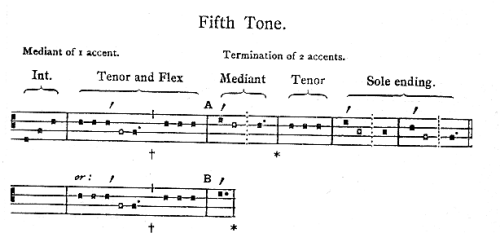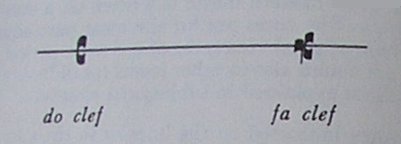Below is an image of Tone 6 in the old square-note notation; there's an alternate melody shown here as well. (Keep in mind that chant notation can be difficult to
read if you're not used to it - but picking up the Psalm Tone melodies
by ear is actually quite easy.
That's the way I learned, and I recommend it highly. You'll find an
audio file (mp3) of the chant further down the page - and there are
links to
all the Tones at the bottom of this post.)
Here's an image of Tone 6 - just the first melody above - in modern notation, from the Lutheran Liturgical Prayer Brotherhood Psalmody Page. The stuff in the parenthesis is the "flex," sung in the first half of the Psalm for a particularly long verse; it's rarely used, so you can safely ignore it for now. Remember, too, that the "incipit" - the notes in the very first measure - are only used once, when singing the first verse; for all subsequent verses, skip directly to the "reciting tone," which is the first note of the second measure, used until you get to the end of the line. (The "reciting tone" is the repetitive note in the chant; it's indicated on the score by the dark, heavy doubled note.)
(Notice that the melody in this score - it's Lutheran-style - is just slightly different than what's pictured in the images above. There are regional and other variations in Psalm-singing.)
Follow along with either notation, while listening to an mp3 of Psalm 112 sung to Tone 6 from the Lutheran Liturgical Prayer Brotherhood Psalmody page. The mp3 includes an antiphon (text: "The generation of the upright shall be blessed") sung before and after the Psalm; don't be confused by the antiphon's melody, which is completely different from that of the Psalm Tone. Remember: it's quite easy to pick up these melodies by ear, so don't be discouraged! Just keep listening and singing.
The translation is the King James Version:
(Here's an even older look at the square-note notation for Tone 6, courtesy of the Order of St. Benedict; you can the alternate melody here, too. These charts are quite a bit more confusing, though, I think - so look at it later, after you've gotten more of the hang of the thing by singing:
)
Here is a good, one-page tutorial on chant notation. On the left is the old Gregorian style; on the right is modern musical notation.
In my opinion, one of the most important things to know - and one of the only things you can't figure out on your own without hearing the music - is the "podatus." Here it is, first in Gregorian notation:

As the tutorial says: "When one note is written above another note like this, the bottom note is sung first, and then the note above it." Here's the modern notation:

That one is used over and over again, and many other neume-types are created from it.
Here are Chantblog pages for all the Psalm Tones, with sound files included at each entry:
Here's an image of Tone 6 - just the first melody above - in modern notation, from the Lutheran Liturgical Prayer Brotherhood Psalmody Page. The stuff in the parenthesis is the "flex," sung in the first half of the Psalm for a particularly long verse; it's rarely used, so you can safely ignore it for now. Remember, too, that the "incipit" - the notes in the very first measure - are only used once, when singing the first verse; for all subsequent verses, skip directly to the "reciting tone," which is the first note of the second measure, used until you get to the end of the line. (The "reciting tone" is the repetitive note in the chant; it's indicated on the score by the dark, heavy doubled note.)
(Notice that the melody in this score - it's Lutheran-style - is just slightly different than what's pictured in the images above. There are regional and other variations in Psalm-singing.)
Follow along with either notation, while listening to an mp3 of Psalm 112 sung to Tone 6 from the Lutheran Liturgical Prayer Brotherhood Psalmody page. The mp3 includes an antiphon (text: "The generation of the upright shall be blessed") sung before and after the Psalm; don't be confused by the antiphon's melody, which is completely different from that of the Psalm Tone. Remember: it's quite easy to pick up these melodies by ear, so don't be discouraged! Just keep listening and singing.
The translation is the King James Version:
Antiphon: The generation of the upright shall be blessed
1 Praise ye the LORD.
Blessed is the man that feareth the LORD,
that delighteth greatly in his commandments.
2 His seed shall be mighty upon earth:
the generation of the upright shall be blessed.
3 Wealth and riches shall be in his house:
and his righteousness endureth for ever.
4 Unto the upright there ariseth light in the darkness:
he is gracious, and full of compassion, and righteous.
5 A good man showeth favor, and lendeth:
he will guide his affairs with discretion.
6 Surely he shall not be moved for ever:
the righteous shall be in everlasting remembrance.
7 He shall not be afraid of evil tidings:
his heart is fixed, trusting in the LORD.
8 His heart is established, he shall not be afraid,
until he see his desire upon his enemies.
9 He hath dispersed,
he hath given to the poor;
his righteousness endureth for ever;
his horn shall be exalted with honor.
10 The wicked shall see it, and be grieved;
he shall gnash with his teeth, and melt away:
the desire of the wicked shall perish.
Antiphon: The generation of the upright shall be blessed
(Here's an even older look at the square-note notation for Tone 6, courtesy of the Order of St. Benedict; you can the alternate melody here, too. These charts are quite a bit more confusing, though, I think - so look at it later, after you've gotten more of the hang of the thing by singing:
)
Here is a good, one-page tutorial on chant notation. On the left is the old Gregorian style; on the right is modern musical notation.
In my opinion, one of the most important things to know - and one of the only things you can't figure out on your own without hearing the music - is the "podatus." Here it is, first in Gregorian notation:

As the tutorial says: "When one note is written above another note like this, the bottom note is sung first, and then the note above it." Here's the modern notation:

That one is used over and over again, and many other neume-types are created from it.
Here are Chantblog pages for all the Psalm Tones, with sound files included at each entry:
- Tone 1 (with mp3)
- Tone 2 (with mp3)
- Tone 3 (with mp3)
- Tone 4 (with mp3)
- Tone 5 (with mp3)
- Tone 6 (with mp3)
- Tone 7 (with mp3)
- Tone 8 (with mp3)
- Tonus Peregrinus (with mp3)





















